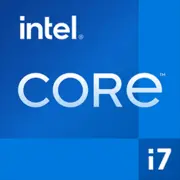Intel Core i7-1280P

Intel Core i7-1280P: モバイルプロフェッショナルのための強力なハイブリッド
(2025年3月)
アーキテクチャとプロセス技術: Alder Lakeのハイブリッドブレークスルー
Intel Core i7-1280Pプロセッサは、Alder Lakeアーキテクチャに基づいており、モバイルソリューション分野の主要なプレーヤーの一つとなっています。このハイブリッド構造は、6つのパフォーマンスコア(Pコア)と8つの省電力コア(Eコア)を組み合わせており、合計で14コア、20スレッドを提供しています。Pコアは、4.8 GHzのターボモードで動作し、レンダリングやコードのコンパイルなどの重い処理を担当し、Eコアは3.6 GHzまで動作し、バックグラウンドプロセスを処理してバッテリー寿命を節約します。
Intel 7プロセス技術(10nm Enhanced SuperFin)は、パフォーマンスと電力消費のバランスを提供します。統合グラフィックスのIntel Iris Xe(96 EU)は、4KディスプレイやAV1デコード、HDMI 2.1をサポートしており、現代のマルチメディアタスクに対応しています。ただし、ゲームには条件付きでのみ適しています:2025年には、CS2やDota 2を中設定でプレイするには十分ですが(50-60 FPS)、AAAタイトルには不足します。
TDPと電力消費: 力とバッテリー寿命の微妙なバランス
プロセッサの定格TDPは28Wですが、ターボモードでは消費が64Wに達することがあります。これにより、ノートパソコンには効果的な冷却システムが必要です。たとえば、コンパクトなウルトラブック(Dell XPS 13 Plusなど)では、過熱を避けるためにチップの出力がしばしば35-40Wに制限されます。冷却機能が向上した大型モデル(HP Spectre x360 16など)では、フルポテンシャルを発揮します。
比較すると、AMD Ryzen 7 7840U(TDP 28W)のような競合は同様の結果を示しますが、単一スレッドの処理には劣ります。Apple M3(MacBook Pro 14内)では、TDP 20WでIntelのエネルギー効率を上回りますが、Windowsソフトウェアとの互換性で劣ります。
パフォーマンス: 仕事と娯楽の万能機
- オフィスタスク: Chromeでの多数のタブの起動、数百万行のExcelスプレッドシートでの作業、Zoomでのビデオ会議など、i7-1280Pは遅延なく処理します。
- マルチメディア: Premiere Proでの4Kビデオレンダリングは、前世代(i7-1185G7)よりも15%減少します。
- ゲーム: Fortniteでは(1080p、低設定)、Iris Xeが安定した60 FPSを出力します。Cyberpunk 2077のようなAAAタイトルでは、eGPUが必要です。
Turbo Boost Max 3.0モードでは、コアが4.8 GHzまで一時的に加速しますが、長時間の負荷(たとえば30分のレンダリング)では、熱制限のために3.9-4.2 GHzに周波数が低下します。
使用シナリオ: i7-1280Pは誰に適していますか?
- モバイルプロフェッショナル: デザイナー、プログラマー、データアナリスト。
- 学生: 3Dモデリングのためのパワーと、講義のためのポータビリティ。
- コンテンツクリエイター: Lightroomでの写真処理や短編動画の編集。
カジュアルゲームを除き、ゲーマーや10時間以上のバッテリー寿命を重視するユーザーにはお勧めできません。
バッテリー寿命: ノートパソコンはどれくらい持つのか?
中程度の負荷(ウェブブラウジング、オフィスアプリ)では、i7-1280P搭載のノートパソコンは6-8時間動作します(たとえば、60 Whバッテリーを搭載したLenovo ThinkPad X1 Carbon Gen 12)。最大パフォーマンスモードでは、2-3時間を超えません。
エネルギーを節約する機能には以下があります:
- Intel Thread Director — PコアとEコア間のタスク割り当てを最適化します。
- Adaptix Dynamic Tuning — バッテリー駆動時に周波数を自動的に低下させます。
競合比較: 誰がリーダーか?
- AMD Ryzen 7 7840U: マルチスレッドタスクに優れています(24スレッド)、しかし、シングルスレッドタスクには劣ります(Geekbench 6 Single-Core ~1850)。
- Apple M3: エネルギー効率と10時間以上のバッテリー寿命ですが、プロフェッショナルソフトとの互換性に制限があります(例:AutoCAD)。
- Intel Core Ultra 7 155H(新世代Meteor Lake): AIタスクで10-12%優れていますが、価格は高めです。
利点と欠点
強み:
- 高いシングルスレッドパフォーマンス。
- Thunderbolt 4およびWi-Fi 6Eのサポート。
- 仕事とマルチメディアに対する汎用性。
弱点:
- 負荷時の過熱。
- ノートパソコンの冷却システムの質への依存。
- 価格: i7-1280P搭載デバイスは$1300(Acer Swift 5)から$2200(Dell XPS 15)まで。
ノートパソコン選びの推奨
1. ウルトラブック(例えば、Asus ZenBook 14X):ポータビリティと高解像度スクリーンに重点を置く。
2. ワークステーション(MSI Prestige 16):向上した冷却機能と独立したグラフィックス。
3. 2-in-1ハイブリッド(HP Spectre x360 16):クリエイティブなタスクのためのタッチスクリーン。
注意すべき点:
- 冷却システム:最低二つのファンとヒートパイプ。
- スクリーン:デザイン用の100% sRGB、インターフェースの滑らかさのために120Hz。
- ポート:eGPUや8Kモニター接続用のThunderbolt 4。
最終結論
Intel Core i7-1280Pは、パワーを重視した汎用的なノートパソコンを必要とする人にとって理想的な選択です。以下に適しています:
- グラフィックやコードを扱うフリーランサー。
- スピードと信頼性を重視するビジネスユーザー。
- 技術系専攻の学生。
主要な利点は、ハイブリッドアーキテクチャ、現代の標準への対応、パフォーマンスとバッテリー寿命のバランスです。予算が$1300–2000で、薄型ボディにパワーを犠牲にすることができない場合、このプロセッサはあなたの選択肢です。
基本
CPUの仕様
メモリ仕様
GPUの仕様
その他
ベンチマーク
他のCPUとの比較
ソーシャルメディアで共有する
または当サイトへのリンクを追加
<a href="https://cputronic.com/ja/cpu/intel-core-i7-1280p" target="_blank">Intel Core i7-1280P</a>